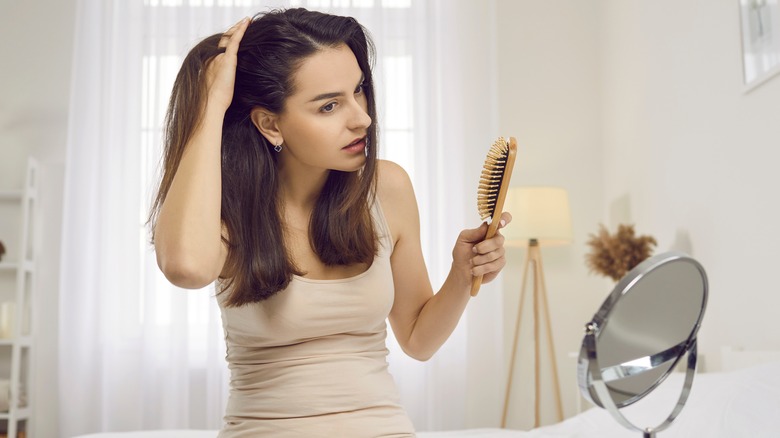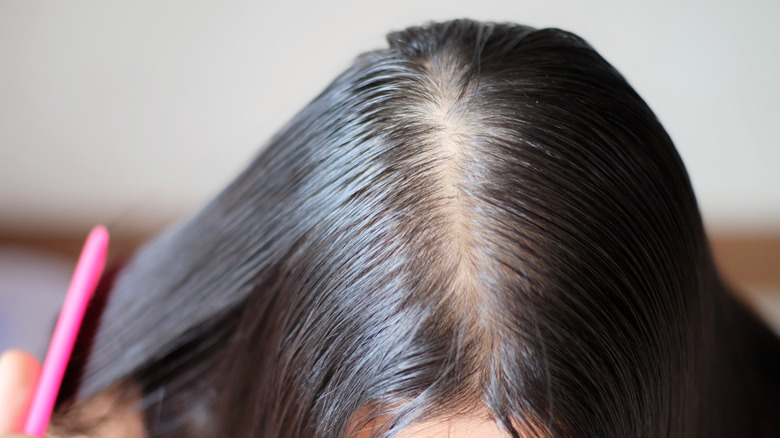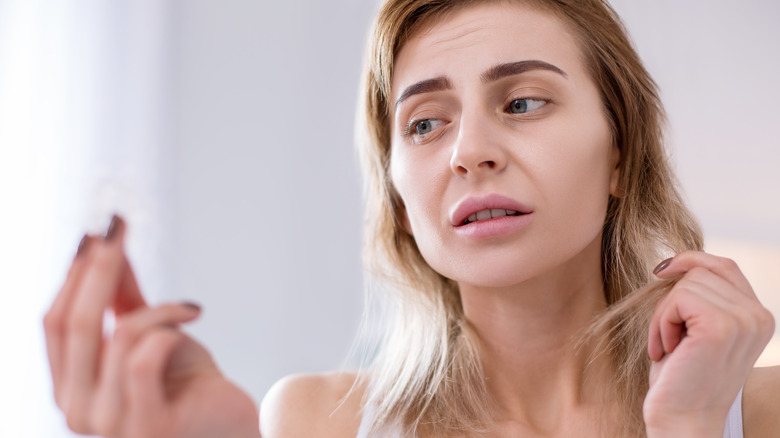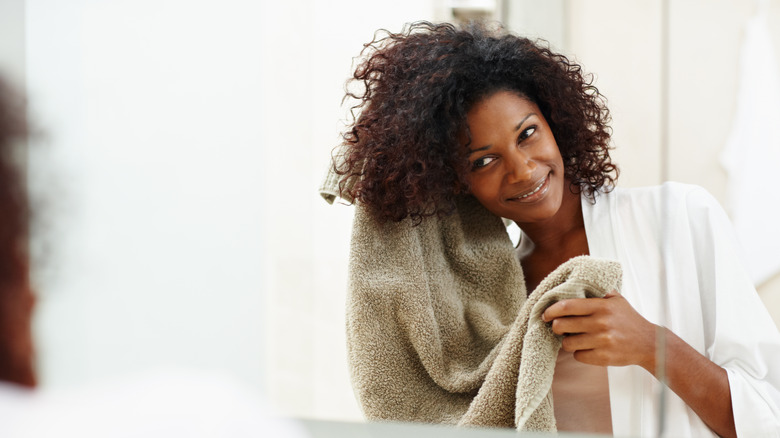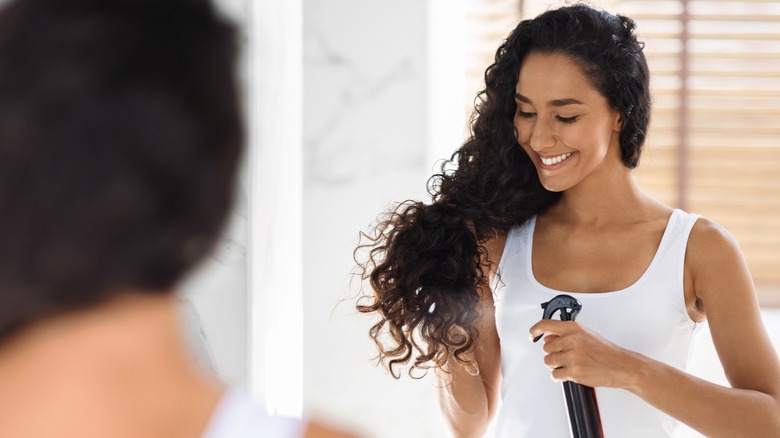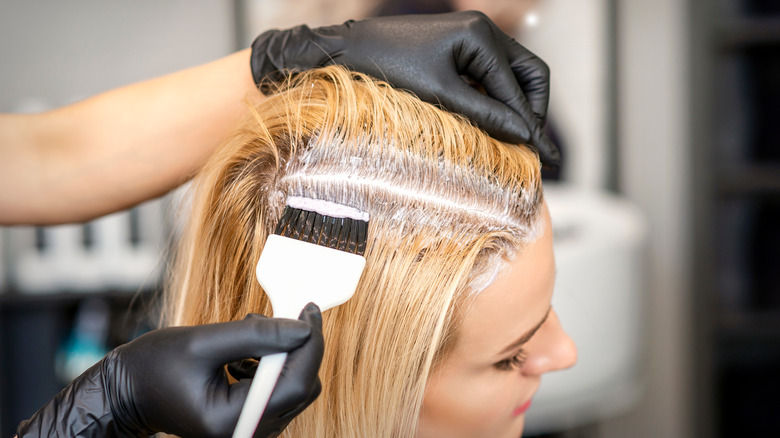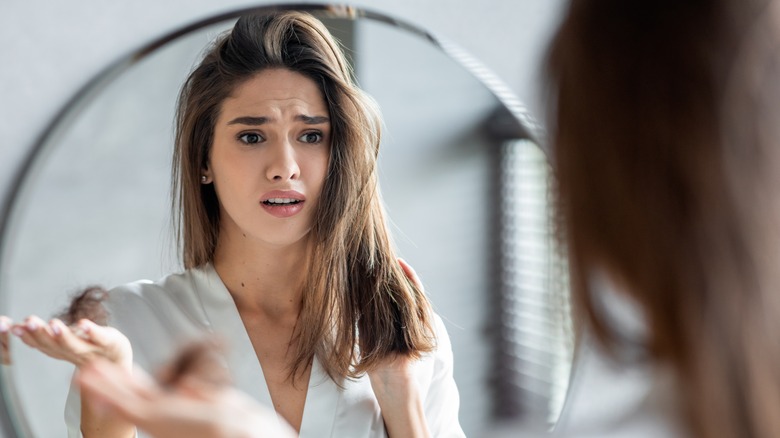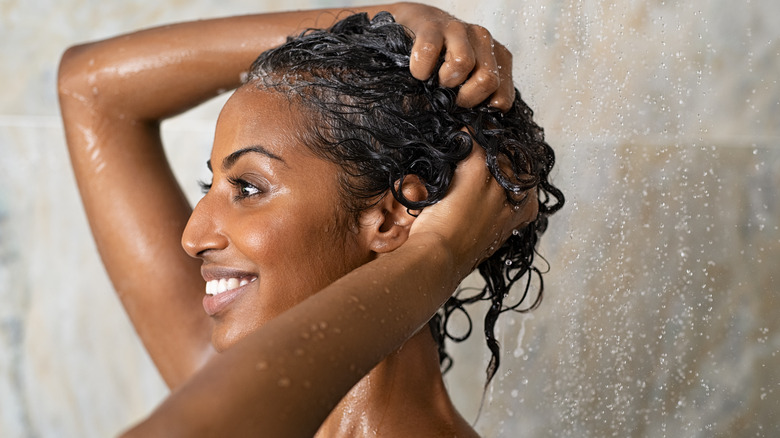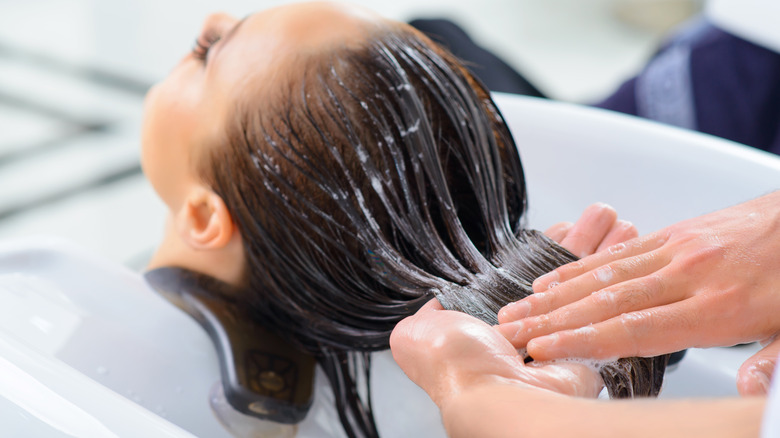8 Things To Be Aware Of Before Thinning Out Your Hair At The Salon
While thick hair has its benefits, many women with this hair type seek thinner tresses. There are a few reasons for this, from thick hair being difficult to manage and style, to European beauty standards glorifying thinner hair over coarser types.
Looking at the issue from a beauty perspective, you should never feel like you have to thin out your hair to fit a standard set by someone else. Your hair is beautiful the way it is (and the global demand for hair extensions and hair fillers just confirms that many women actually wish they had thicker hair!). But if you want to thin out your hair because it's difficult to style or manage, your hairdresser can definitely help.
There are a few ways to safely thin out hair, and one of the most effective processes uses thinning shears. These shears typically have two blades, one with teeth and one without, and they remove small sections from the hair without reducing the length, per Leaf Scissors. However, if you have curly locks, your hairdresser will likely thin your hair out by cutting layers, as thinning shears don't typically produce great results with curls.
When thick hair is cramping your style, thinning it out can literally take a weight off your shoulders. However, there are a few things to keep in mind.
1. It will get greasy faster
One of the major upsides of having thick hair is that you'll generally be able to get away with washing it less often. This is because thick hair is more porous than finer hair, so it's able to absorb more of the oils that your scalp naturally produces. While it may sound like this would make your hair greasier, the fact that oil is being absorbed into your hair rather than sitting on the top, like it does with less porous fine hair, means that your hair simply doesn't look or feel as oily.
Thinning out your hair doesn't actually change your hair type or the dynamics of your hair shaft, but it can make your hair feel dirtier more quickly. When you're used to the cleansing schedule of a thick-haired gal, this can take quite a while to get used to.
Along with washing your hair more frequently, you may have to use dry shampoo in your routine to keep your hair looking fresh between washes. You could also try washing your pillowcase more often and air-drying rather than heat-styling to make your hair less greasy.
2. Beware of over-thinning
Thinning your hair can be life-changing if your thick hair is too much to manage, but you want to be careful of over-thinning it. Since you likely won't be the one thinning out your own hair, this is more of a warning to make sure you use a hairstylist who knows what they're doing.
An inexperienced stylist can shear too much of your hair or cut too many layers if they aren't properly trained. Makeup.com explains that this can lead to too much volume left behind, because of the difference between the short layers and the rest of the hair. Specifically with the case of shearing, overdoing it may leave your hair ratty and frayed.
To avoid this, use a stylist you can trust, and explain that you only want to thin your hair out a minimal amount. It's better to err on the side of caution; if your hair is still too thick after, you can always thin it out further, but you can't add back hair that you've taken off.
3. The effects on curly and straight hair are different
The other reason why an experienced hairstylist is crucial is because the thinning process is different depending on your hair type. As Leaf Scissors notes, thinning scissors used on curly hair can "ruin the curl pattern" and result in frizzier hair, so it's better to thin the hair out with layering. A novice stylist might not be aware of this.
Even with the use of layering, the thinning out process tends to have a different effect on curly hair than it does on straight hair. With curly hair, the final result is often subtle and less noticeable (when done right). Thinning out is more obvious on straight hair because of the way that straight hair naturally falls, per You Probably Need a Haircut. That said, the website also explains that thinning out curly hair can result in tighter curls and a slightly different wave pattern.
4. It may not hold styles in the same way
A major reason why you may choose to get your hair thinned out in the first place is because it's too difficult to style as it is. Keep in mind that while thinning your hair out may make it easier to style, it can also change the final look and function of your go-to styles more than you realize.
Thick hair tends to hold curls and heat styling more effectively than thin hair, so once you've thinned out your hair, you may need to take extra measures to maintain those styles. Often, you'll have to use more hairspray and invest in other beauty products to get the same results. You may also have to adjust how you actually heat style. For example, thinner straight hair may require a thinner barrel on your curling iron, or a lower heat setting.
If you have generally shorter hair, layering or thinning may cause your hair to rise in volume at the top of your head, as hair is typically thinned out from the middle of the strand, leaving the weight at the top.
5. Bleaching it may cause it to thin on its own
One thing to definitely keep in mind is that if you plan to bleach your hair, you may find that it thins on its own. Bleach damages the hair shaft over time, so if you don't take measures to restore moisture and regularly trim your hair, it will likely become frayed and stringy. Depending on how thick your natural hair is, it might not be a good idea to thin out your hair in conjunction with bleaching it.
Some hair types are so thick and coarse that bleaching it and thinning it out still won't result in you having less hair than you'd like. But if your hair isn't super thick naturally, and you're only thinning it to try out a different style, it's best not to thin it out and bleach it at the same time. You could easily end up with much less hair than you'd like.
6. Your hair can naturally change over time
Besides bleaching, there are other things that can lead to your hair naturally becoming thinner over time. According to Healthline, some of the major causes of thinning hair include long-term stress, hormonal changes, underlying medical conditions or autoimmune disorders, wearing tight hairstyles, and nutrient deficiencies. If you experience any of these or they're likely to happen to you, think twice before thinning your hair out with a stylist.
Of course, there are many causes of hair loss that you can't plan for in advance. We're not saying that you shouldn't thin out your hair because you might develop alopecia in the future, for example, or because you might be stressed in the upcoming months. But if you do reasonably anticipate any of these changes (for example, pregnancy), it pays to wait and see how that affects your hair before you take any off.
7. You may have to change shampoo and conditioner
Thinning out your hair won't change your hair type, but it can still mean that you need to change up your shampoo or conditioner routine. If you have super thick or coarse hair, you might be used to using products that inject a lot of moisture and hydration into your mane. But when you use those same products on your hair once it's been thinned out, it may weigh your strands down and make your hair look flat or oily.
Finding the right shampoo and conditioner can involve some trial and error. You won't know exactly how your hair responds to certain products until after you've had it thinned. If you do find that your old shampoo isn't working for you anymore, don't throw it out straight away. You might be able to use it again when your hair grows back (as long as it's not past the expiration date!).
8. There are alternatives
Thinning out your hair with shears or with layers often means that it will take a while to return to its original thickness. It's a long-term decision, and if you aren't ready to make that kind of commitment, you do have other options.
All Things Hair explains that it's possible to reduce the volume of your hair with more temporary methods, like keratin treatments. These tend to last around three months and make your hair feel finer without actually changing the texture. You can buy at-home keratin treatments online, or you can enquire about having one done at a salon near you. A quick Google search should turn up some options.
The other step you can take is investing in haircare products that banish frizz, since this can be the culprit behind hair feeling thicker than it is. Go for anti-frizz shampoos, along with hydrating conditioners and treatments to leave your tresses feeling smooth.
If you do decide that thinning your hair out is the right step for you, you'll be on your way to more manageable hair. Just make sure that you take the time to find the right stylist and you're aware of all the potential changes your hair will be going through.
